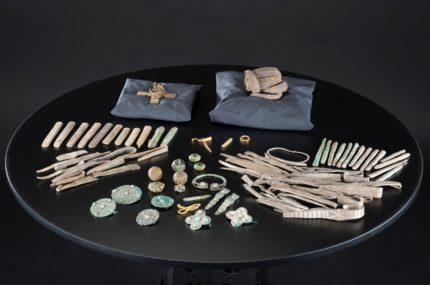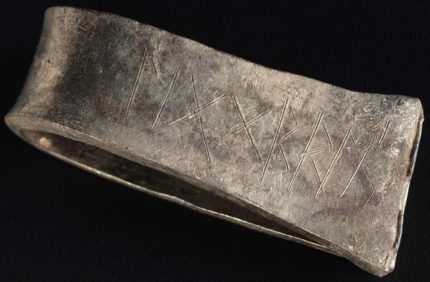 The question of who owned a hoard is usually a rhetorical flight of fancy, at best, but the Galloway Hoard is unique in that there were actual names inscribed on some of its artifacts. Written in Anglo-Saxon runic script (unusual for arm-rings of this type which were typically inscribed in Scandinavian runes) there were four inscriptions on the arm-rings found in the lower layer deposit of hacksilver and a fifth one found on an arm-ring near the hoard pit. Now, 11 years after the discovery of the largest and most varied Viking-era hoard ever discovered, the longest runic inscription has been translated, and it sheds new light on the question of who owned this treasure.
The question of who owned a hoard is usually a rhetorical flight of fancy, at best, but the Galloway Hoard is unique in that there were actual names inscribed on some of its artifacts. Written in Anglo-Saxon runic script (unusual for arm-rings of this type which were typically inscribed in Scandinavian runes) there were four inscriptions on the arm-rings found in the lower layer deposit of hacksilver and a fifth one found on an arm-ring near the hoard pit. Now, 11 years after the discovery of the largest and most varied Viking-era hoard ever discovered, the longest runic inscription has been translated, and it sheds new light on the question of who owned this treasure.
 The fifth arm-ring inscription was the first to be translated. In 2019, Dr. David Parsons, a leading runologist at the University of Wales, deciphered the runes as reading EGGBRECT, the runic version of the Old English name Ecgbeorht (Egbert in modern English). The arm-ring was hacked, and the last rune squeezed onto it, so it was inscribed after it was cut. This discovery suggested that the people who deposited the hoard were culturally English rather than Norse, and may have even been locals from Anglo-Saxon Northumbria.
The fifth arm-ring inscription was the first to be translated. In 2019, Dr. David Parsons, a leading runologist at the University of Wales, deciphered the runes as reading EGGBRECT, the runic version of the Old English name Ecgbeorht (Egbert in modern English). The arm-ring was hacked, and the last rune squeezed onto it, so it was inscribed after it was cut. This discovery suggested that the people who deposited the hoard were culturally English rather than Norse, and may have even been locals from Anglo-Saxon Northumbria.
 The other four inscriptions posed greater challenges. Three of them were abbreviated and therefore open to several interpretations. The lightest of the arm-rings was inscribed with the runes ED. It could mean “ēad” (riches, prosperity), or be the first two letters of a name like Edward or Edgar. Another light one bore the runes TIL, which could mean “good,” or be short for a name like Tilred. The third, which is twice the weight of the lightest one, is inscribed BER. Unlike the other two inscriptions, these runes do not form an Old English word. It is, however, the first syllable of several Anglo-Saxon names (Berric, Berwulf, Bercol), so it is likely an abbreviation of a personal name, which suggests the other two are as well.
The other four inscriptions posed greater challenges. Three of them were abbreviated and therefore open to several interpretations. The lightest of the arm-rings was inscribed with the runes ED. It could mean “ēad” (riches, prosperity), or be the first two letters of a name like Edward or Edgar. Another light one bore the runes TIL, which could mean “good,” or be short for a name like Tilred. The third, which is twice the weight of the lightest one, is inscribed BER. Unlike the other two inscriptions, these runes do not form an Old English word. It is, however, the first syllable of several Anglo-Saxon names (Berric, Berwulf, Bercol), so it is likely an abbreviation of a personal name, which suggests the other two are as well.
But it was the runic inscription on the largest of the arm-rings, the longest by far, that posed the greatest translation challenge. The arm-ring is unique in the hoard as it is decorated with a Hiberno-Norse stamped design; the other arm-rings with runes have no decoration. This one was also a finished ring, instead of thin, bent sheets of silver that were never completed. Dr. David Parsons was able to transliterate each individual rune, but the meaning of the inscription proved elusive.

Despite using clearly legible Anglo-Saxon runes like the others, it did not at first appear to contain a coherent message. It also has an odd sequence of the rune ɨ followed by i. The letter ɨ is used to represent the thirteenth rune ᛇ, the ‘velar fricative’ represented by ‘gh’ in words like ‘almighty’. In modern English this is silent, but in Old English it would have sounded something like the end of the Scots word ‘loch’. It is rarely if ever used at the start of a word, much less followed by another vowel. […]
The breakthrough for translation came when looking down the microscope, and it became clear the final rune had dots to either side. Centrally-placed dots like these, called puncts, could be used in medieval manuscripts to denote an abbreviation, or the name of the rune: in this case the F-rune which is called ‘feoh’, a word which also means ‘wealth’ or ‘property’. A new look at the inscription showed that there was possible word spacing in the runic inscription, allowing us to break it down into four words: DIS IS ƗIGNA F[EOH].
This gets us closer to one possible reading. If we allow for an odd pronunciation, it could be that DIS IS is an attempt at ‘this is’. ƗIGNA is more problematic – but the ‘gh’ in ‘almighty’ was sometimes written simply as ‘h’ in Old English. If ᛇ could be used for ‘h’ here, the text would read ‘higna’, a word which means ‘community’, particularly used for monastic or other religious communities.
With all these caveats in mind, the long inscription may well be understood as:
þis is higna feoh
“This is the community’s property.”
 The runic inscription thus translated dovetails into the interpretation of the hoard itself as something that had multiple owners rather than belonging to an individual. The long inscription could be referring to the deposit, either the lower layer of hacksilver or the entire hoard, as the “community’s property.” The word “higna” usually refers to a monastic community, and the hoard contains some spectacular ecclesiastical objects, including a large pectoral cross and the lidded vessel.
The runic inscription thus translated dovetails into the interpretation of the hoard itself as something that had multiple owners rather than belonging to an individual. The long inscription could be referring to the deposit, either the lower layer of hacksilver or the entire hoard, as the “community’s property.” The word “higna” usually refers to a monastic community, and the hoard contains some spectacular ecclesiastical objects, including a large pectoral cross and the lidded vessel.
* This article was originally published here











No comments:
Post a Comment